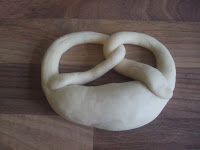For those who know Germany (and its baking landscape) my first recipe clearly gives away where I grew up. The Laugenbrezel – a savoury shape baked from yeast dough and with a distinctive brown and chewy crust – can be found mainly in the south of Germany. The best brezels, even if I say so myself, come from the south-west, from Baden-Württemberg (and not from Bavaria!) and particularly from the Stuttgart region. Legend has it that the Laugenbrezel was invented by a baker from Bad Urach, a small town not too far from Stuttgart. Having committed a crime he was sentenced to death by hanging. However, as this was the baker’s first offence the local monarch agreed to give him a last chance: if he succeeded in baking a cake through which the sun could shine three times his life would be spared. The baker went to work and the brezel was the result of his labour.
I love brezels and (apart from my parents) they are what I miss most when I remember Germany. There is only one small complication, which has previously held me back from making my own and homemade version: the distinctive brown and chewy crust of a real brezel can only be achieved properly if it is dunked in a 4% caustic soda solution before baking. Some say that boiling some baking soda in water brings similar results... But this hasn’t made me happy. So finally, on my last trip to Germany, I acquired caustic soda solution in a pharmacy and successfully got the odd-looking bottle covered in hazard signs through Eurostar security... I have not tried to buy food-grade caustic soda in the UK. You might be able to get it from a friendly pharmacist, but I am fairly sure it can also be bought online. You only have to be persistent. It is definitely worth it.
Edit (4th March 2012). A few weeks ago I tried baking the Brezels with a baking soda solution, just because it is so difficult to get the 'proper' caustic soda outside of Swabia. The texture and flavour is not quite the same and they are not quite as shiny, but the result was not too bad. It is certainly better than no Brezels at all! Unlike the caustic soda solution, which is applied cold (indeed, it would be dangerous to heat this up), the baking soda is used with boiling water. Boil 3 tablespoons of baking soda in 2 litres of water for about 10 minutes. Then boil each raw Brezel in this solution for about 20 seconds and leave to drain. Sprinkle with coarse sea salt and bake as below.
This recipe makes about 16-20 medium-sized brezels:
1 kg plain flour (you can also use spelt flour or a mix of both)
35g fresh yeast (or 2 sachets dry)
A pinch of sugar
500 ml lukewarm milk or water or a mix of both (I used half milk, half water)
75 g butter
2 teaspoons salt
coarse sea salt for sprinkling
4% caustic soda solution (about 300 ml)
Dissolve the yeast in the warm liquid and knead all ingredients until you have a firm and relatively dry dough. Leave this to rise in a covered bowl until it has doubled in size (30 minutes to 2 hours).
Divide the dough into 16-20 pieces and roll each piece into a strip around 50 cm long. The centre of the strip should be thicker and the ends should be thin. Form each strip into a brezel shape and leave to rise for a few minutes on a baking sheet covered in baking paper (other shapes, such as oblong rolls, plaits or knots are also possible and typical for this kind of bread. These are also quicker to make).
In order to make the brezels’ bath in the caustic soda solution easier it is best to freeze the unbaked brezels for a few minutes (this makes them easier to handle). Put the caustic soda solution into a large enough plastic food container with a tight-fitting lid. Bathe each brezel in this solution for about 30 seconds (turning once). Make sure to wear rubber gloves and maybe goggles, because ‘unbaked’ the solution should not get in contact with the skin or eyes. I also use metal spoons to dunk and turn the brezels and to retrieve them from the caustic soda. The rest of the solution can be kept with a firm lid on until the next time. Just make sure you label it well and keep it out of children’s reach.
Slit the thick part of the brezel (its ‘belly’) with a sharp knife or razor blade so it can rise and will not split randomly on the sides. Sprinkle with coarse sea salt and bake in the oven at 200 degrees for about 20 minutes (or until the kitchen smells fantastic and the brezels have their typical, dark brown colour).
Enjoy them warm and with some cold, salted butter. They are great for breakfast, lunch, afternoon tea, dinner and as a snack :)






No comments:
Post a Comment